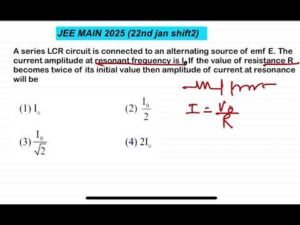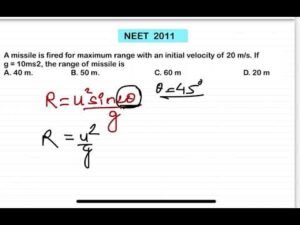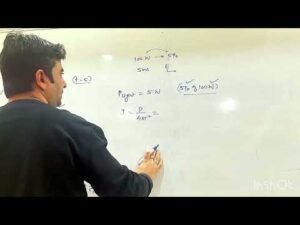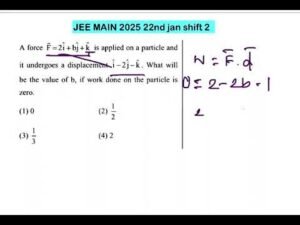Description
*2024(29th jan shift 2) solutions***😃
****2024 complete solution playlist**😃🤘🏻
*****2025 complete solution playsit*****
***All JEE Main/AIEEE questions playlist***😃🤘🏻
***All NEET PYQs playlist***😃🤘🏻
✅✅✅😃You can also find for chapterwise playlist of JEE MAIN and NEET on the channel👍🏻👍🏻✅✅✅
#jee,#jeemain,#iitjee,#neet,#pyq,#importantquestions,#jeemainpapersolution,#jeemain2025,#physicsmonk
Given below are two statements :
Statement I : Most of the mass of the atom and all its positive charge are concentrated in a tiny nucleus and the electrons revolve around it, is Rutherford’s model.
Statement II : An atom is a spherical cloud of positive charges with electrons embedded in it, is a special case of Rutherford’s model.
In the light of the above statements, choose the most appropriate from the options given below.
(1) Both statement I and statement II are false
(2) Statement I is false but statement II is true
(3) Statement I is true but statement II is false
(4) Both statement I and statement II are true
Welcome to Allen.AskDoubtnut.com – India’s Largest Platform for Instant Doubt Solutions
Allen.AskDoubtnut.com is the ultimate destination for instant video solutions to your doubts in Physics—from Class 11th to JEE Advanced and NEET level. With a growing library of over 15 lakh+ expert-created video solutions, we make learning fast, easy, and effective.
Just click a photo of your doubt using the AskDoubtnut in the end and submit in google, and get an instant, step-by-step video explanation. It’s the simplest way to solve doubts in seconds—whether you’re studying for CBSE board exams, IIT-JEE, NEET, or any other competitive exam.
Why AskDoubtnut.com?
• 10,00,000+ Free Video Solutions
• Covers NCERT, JEE Main, JEE Advanced, NEET, and State Boards
• Unlimited Doubt Solving with Just One Click
• Instant, Concept-Based Answers by Experts
• 24×7 Learning Support via the AskDoubtnut App
Trusted by millions of students across India, Allen.AskDoubtnut.com helps you turn doubts into confidence. No more waiting—ask, learn, and grow with Allen.AskDoubtnut.com!
- Master JEE Physics: Solve Unpolarised Light Intensity with Polaroid Filters
- JEE MAIN 2024 Power of Light Intensity Derivation | JEE/NEET Solutions
- JEE MAIN 2024(29th Jan Shift 2) Wire Length & Radius Solutions | Allen.AskDoubtnut
- JEE MAIN 2024(29th Jan Shift 2) Solutions: Revolution Time Reduction | Watch Now!
- JEE MAIN 2024(29th Jan Shift 2) Gas Mixture Problem Solution | NEET/JEE Doubt
- Master JEE Physics: How to Solve Unpolarised Light Intensity with Polaroid Filters
- JEE MAIN 2024 Power of Light Intensity Derivation | JEE/NEET Solutions | Watch Now!
- JEE MAIN 2024(29th Jan Shift 2) Wire Length & Radius Solutions | Allen.AskDoubtnut
- JEE MAIN 2024(29th Jan Shift 2) Solutions: Revolution Time Reduction | Watch Now!
- JEE MAIN 2024(29th Jan Shift 2) Gas Mixture Problem Solution | NEET/JEE Doubt – Find Nmoles of Gas
- NEET 2025:To an ac power supply of 220 V at 50 Hz, a resistor of 20 Ω, a capacitor of reactance 25
- NEET 2025: (By 2 methods)In some appropriate units, time (t) and position (x) relation of a moving p
- NEET 2025: AB is a part of an electrical circuit (see figure). The potential difference “VA – VB”, a
- NEET2025:The electric field in a plane electromagnetic wave is given byEz = 60 cos (5x + 1.5 × 109
- NEET 2025:A ball of mass 0.5 kg is dropped from a height of 40 m. The ball hits the ground and rises
Frequently Asked Questions
How to prepare for IIT-JEE Physics?
To prepare for IIT-JEE Physics, focus on understanding concepts rather than memorizing formulas. Practice solving a variety of problems, especially previous years’ questions. Create a study schedule that covers all topics, with extra time for challenging areas like Mechanics and Electromagnetism. Regular revision and mock tests are essential for success.
What is the difference between elastic and inelastic collisions?
In elastic collisions, both momentum and kinetic energy are conserved. Examples include collisions between hard billiard balls. In inelastic collisions, only momentum is conserved while some kinetic energy is converted to other forms like heat or sound. Most real-world collisions are inelastic to some degree.
What is the difference between electric potential and electric potential energy?
Electric potential is the electric potential energy per unit charge, measured in volts (V). It’s a property of a point in space. Electric potential energy is the energy possessed by a charge due to its position in an electric field, measured in joules (J). It depends on both the charge and its position.







